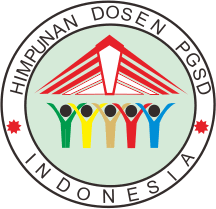Pemahaman konsep matematika siswa kelas IV sekolah dasar materi luas dan keliling bangun datar berbantu media youtube
Abstract
This study aims to describe the results of the analysis of students' understanding of mathematical concepts, and the indicators that are mastered and not yet mastered by students in terms of area and circumference of flat shapes for YouTube video media during the limited PTM period. The research method used is descriptive qualitative method with case study. The subjects in this study were students of class IVA at SDN Panularan No. 6 Surakarta in the academic year 2021/2022. The number of students as many as 28 people. Data collection techniques used are observation, interviews, tests, and documentation. The data analysis technique used is analysis according to Miles and Huberman through 3 stages, including data reduction, data presentation, data verification/conclusion. The results showed that students' understanding of mathematical concepts on the area and perimeter of flat shapes using youtube video media in class IVA SDN Panularan No.06 Surakarta was generally in the medium category. In this study, 5 indicators of mathematical concept understanding were used, 3 indicators were categorized as medium, and 2 indicators were categorized as low. Indicators included in the moderate category include: restating the concepts learned, presenting concepts in mathematical form, developing the requirements of a concept by choosing procedures to be used in solving problems, while the 2 indicators are classifying objects according to certain properties based on mathematical concepts , and applying the concept in a problem is still low.
Keywords
References
“Undang-Undang Nomor 20 tahun 2003 tentang Sistem Pendidikan Nasional.”
I. Isrokatun, I., Hanifah, N., Maulana, M., & Suhaebar, Pembelajaran Matematika dan Sains secara Integratif melalui Situation-Based Learning. UPI Sumedang Press, 2020.
M. E. A. Saputra and M. Mujib, “Efektivitas Model Flipped Classroom Menggunakan Video Pembelajaran Matematika terhadap Pemahaman Konsep,” Desimal J. Mat., vol. 1, no. 2, p. 173, 2018, doi: 10.24042/djm.v1i2.2389.
E. Unaenah and M. S. Sumantri, “Analisis Pemahaman Konsep Matematis Siswa Kelas 5 Sekolah Dasar Pada Materi Pecahan,” vol. 3, no. 1, pp. 106–111, 2019.
A. Y. Ginanjar, “Pentingnya Penguasaan Konsep Matematika Dalam Pemecahan Masalah Matematika di SD,” J. Pendidik. UNIGA, vol. 13, no. 1, pp. 121–129, 2019, [Online]. Available: www.jurnal.uniga.ac.id
A. Mulia Nastiti, H. Nindiasari, and Novaliyosi, “Analisis Kemampuan Berpikir Kritis Matematis Siswa Smp Dengan Pembelajaran Daring,” Wilan. - J. Inov. dan Ris. Pendidik. Mat., vol. 1, no. 4, pp. 341–352, 2020, [Online]. Available: http://www.jurnal.untirta.ac.id/index.php/wilangan
E. Nurdin, A. Ma, Z. Amir, and M. P. Azmi, “Pemanfaatan video pembelajaran berbasis Geogebra untuk meningkatkan kemampuan pemahaman konsep matematis siswa SMK,” vol. 6, no. 1, pp. 87–98, 2019.
M. Suwarno, “Potensi Youtube Sebagai Sumber Belajar Matematika,” Pi Math. Educ. J., vol. 1, no. 1, pp. 1–7, 2017, doi: 10.21067/pmej.v1i1.1989.
K. R. Fadillah, S. Marmoah, and Hadiyah, “Analisis dampak pembelajaran matematika berbantuan media youtube terhadap kemampuan berpikir kreatif siswa kelas V di sekolah dasar selama social distancing,” J. Didakt. Dwija Indria, vol. 9, no. 5, pp. 2–6, 2021.
M. Haryadi, “Pemanfaatan Youtube Sebagai Media Ajar Dalam Meningkatkan Minat Dan Motivasi Belajar Haryadi Mujianto Program Studi Ilmu Komunikasi , Peminatan Public Relations , Universitas Garut email : haryadimujianto@uniga.ac.id Pendahuluan Youtube adalah media sosia,” J. Komun. Has. Pemikir. dan Penelit., vol. 5, no. 1, pp. 135–159, 2019.
S. R. Fauziah, S. Rismen, and L. Lovia, “Analisis Kemampuan Pemahaman Konsep Matematis Siswa di Era New Normal,” Lattice J. J. Math. Educ. Appl., vol. 1, no. 1, p. 45, 2022, doi: 10.30983/lattice.v1i1.4744.
A. Setiawan, P. Studi, P. Matematika, and U. M. Purworejo, “Penerapan Model Pembelajaran Generative Untuk,” pp. 199–204.
D. H. Schunk, Learning theories: An educational perspective, vol. 5. PEARSON, 2012.[Online]. Available: http://www.amazon.com/Learning-Theories-Educational-Perspective-6th/dp/0137071957
W. . HILL, Theories Of Learning: Teori-teori Pembelajaran Konsepsi, Komparasi dan Signifikan. NUSAMEDIA, 2019.
M. N. Arifin, “Peningkatan Pemahaman Konsep Bangun Datar Dengan Menggunakan Media Realia Pada Pembelajaran Matematika Pada Siswa Sekolah Dasar,” JPI (Jurnal Pendidik. Indones. J. Ilm. Pendidik., vol. 5, no. 2, pp. 29–34, 2019.
H. Mahfud, I. R. W. Atmojo, and R. Ardiansyah, “Penggunaan Model Connecting, Organizing,Reflecting, Extending (Core) Untuk Meningkatkan Pemahaman Konsep Peraturan Perundangan Tingkat Pusat Dan Daerah),” no. 82, pp. 9–25, 2019.
Z. Amir and Risnawati, Pembelajaran matematika.
Refbacks
- There are currently no refbacks.



